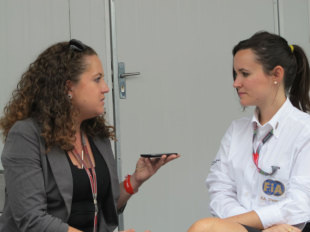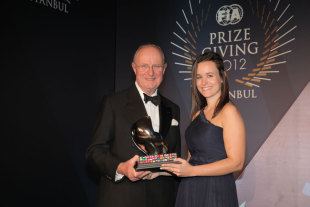- Feature
Inside the stewards' office

The Formula One paddock is filled with faces the public doesn't know much about, key figures and officials who do the bulk of their work far from the public eye. One such face is that of Silvia Bellot, an FIA rising star from Barcelona.
A keen motorsport fan from a young age - influenced in no small part by her father, who was president of the Spanish Rallying Federation - Bellot is the first graduate of the FIA's steward training programme, which emerged from efforts to revamp stewarding in 2008 and 2009.
"My father has been involved in motorsport all his life, so I grew up inside this world," Bellot says, gesturing to the organised chaos of the Interlagos paddock. "My father used to work in rallies, but I prefer Formula One.
"I started when I was 16," she explains. "I took my exams to be a marshal, and then when I was 18 I started to steward. So it's been a long time. I tried to race cars when I was younger, but my mother said no. She said 'you can be involved as a steward, but not as a driver!'. My mother was really worried about the cars and everything, so…"
While the 25-year-old might seem at first glance to be rather a fresh face for the responsibility of stewarding, Bellot has more than earned her spurs over the course of the past decade, sitting on the stewards' panel across a range of high-level categories: GP2, GP3, WSR, WRC, and DTM, to name but a few.
In an interview with Spanish newspaper Marca that was published before her F1 debut at Istanbul Park last year - a debut that also saw the Barcelona native become the FIA's first permanent Spanish F1 steward - Bellot admitted that stewarding had long been her dream: "As a child my dream was to be the first woman to become commissioner and I have come up young."
Bellot's life-long dedication to motorsport has seen her achieve lofty goals at a young age. The girl who started marshalling at 16, and first served as an FIA steward at a Formula One Grand Prix at the age of 24 was honoured by the governing body this December, when she was named the winner of the Outstanding Official Award at the FIA Gala in Istanbul.

Given the speed with which she has climbed the ladder of motorsport success, such accolades are hardly surprising. Having started out as a 16-year-old marshal, by the age of 18 Bellot had joined the Spanish Assembly and the Circuit de Catalunya officials' committee. Her already impressive motorsports CV includes stints as the permanent chairman of the stewards for the European F3 Open and Spanish Endurance Championships and permanent steward of the GT Open International Championship, in addition to an extensive list of national championships across Spain.
An attempt to bring greater consistency to the judgments made over the course of the season saw the FIA review the stewarding process. One of the recommendations made was that serving stewards be required to observe at least one grand prix before actively officiating, and that up and coming young officials be invited to F1 weekends as observers, a suggestion that was adopted in 2009.
It was in 2009 that Bellot joined the FIA's trainee stewards' programme, learning the ropes in GP2 and F1 before serving as a steward for the first time at the 2011 Turkish Grand Prix. Since then, Bellot has stewarded at five other Formula One weekends: the 2012 Brazilian Grand Prix and the 2011 and 2012 Italian and Spanish Grands Prix.
"When I was a trainee steward, I spent some time as an observer. After that I did GP2 and GP3, and I guess I did it well because I'm here now," she laughs. "I learn a bit more with every race. Each incident is different, so you learn all the time. I'd love to come to every race, but there are so many stewards."
The basic role of a steward is not one that has changed with time, but the technology available to the stewards is ever-evolving. FIA stewards now have access to a variety of static and on-board camera feeds, GPS data, and telemetry, with new technology emerging every year. Supplementing all of the technology is an old-fashioned exploration of the track and its potential flashpoints.
"On Fridays we normally arrive [at the circuit] before free practice, so we can do some laps in the medical car and identify the more difficult corners, the places we're more likely to have incidents, that sort of thing," Bellot reveals. "As for leaving, that depends - normally we'd leave around an hour after the end of the session, but if there are incidents…
"We have to check each incident really carefully, because [the outcome] is so important. We check it really carefully - we assess all the data, we take the cameras, the GPS system, everything. We take a careful look at the incident and the data, then we make our decision. We try to be as fast as possible, but we have to be right."

Having been trained to watch the racing with a professional eye, is it difficult to switch off and just enjoy the action when watching a race from home? "No, I watch it as a steward!" Bellot laughs. "My father and my sister are always watching like real fans, but I can't help it - I watch like a steward."
But watching like a steward at the circuit is a very different experience to watching with a keen eye for incidents at home. As was shown to be the case after the 2012 season finale, F1 fans can be very opinionated when it comes to the rights and wrongs of a stewarding decision, or definition of what does and doesn't constitute a racing incident.
"Because we've got more information than the media, or the fans at home, it can be difficult," Bellot concedes. "If the fans and the media had access to the same data, they'd come to the same decisions. We've got a really good [computer] program. Each year we're improving it, adding more data. Now, for example, we've got telemetry streamed in real time, which is really good for us - we can check where the drivers were and what they were doing. We try to improve it each year."
In an interview with this month's issue of AUTO, the FIA's new magazine, Gary Connelly explained the wealth of data now available to the Formula One stewards, and the great leap forward made in 2012.
"First of all, we have all the video feeds - the pictures that have gone to air; the vision captured by FOM but which hasn't been put to air; the closed circuit cameras around the track, and all the on-board material as well," he said. "We have GPS tracking, which shows where cars are at any given time. We also have access to all the team radio transmissions, which are very important as they allow us to know if a team has warned a driver that he's about to impede another car and whether a driver has ignored that information.
"Finally, as of this summer, we can now obtain real-time telemetry from the cars. That's really useful as we can overlay telemetry information from an incident with data from previous laps, so we can tell if a driver has done something like failing to back off under yellow flags. Linking all this together you can come up with a complete picture of what's going on.
"You have a mass of information that isn't available to the public or the teams," Connelly concluded. "That's why decisions are sometimes taken that people have trouble understanding, but they simply don't have all the information the stewards do."

